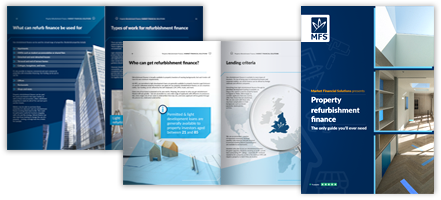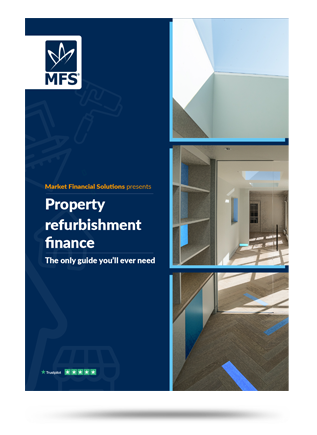Disclaimer
Market Financial Solutions are a bridging loan and buy-to-let mortgage provider, not financial advisors. Therefore, Investors are encouraged to seek professional advice. The information in this content is correct at time of writing.

In the current climate of high inflation, rising interest rates, and plateauing house prices, many will be considering ways to increase the value of their homes. Extending a property is one way of doing this. We are frequently asked how to fund an extension, while some borrowers remain in the dark about the amount they can borrow. Let alone the factors that can influence these amounts. If you are considering an extension and have similar questions, this blog should provide some clarity.
What is an extension?
First, let us define what an extension is. In short, the term ‘extension’ means to extend a property that already exists to increase its overall floor size on ground level. However, that is not to say that extensions cannot be more than one storey.
Usually, this is done by adding another room, or making an existing room larger. For the most part, extensions require you to sacrifice a part of your garden or driveway. Sometimes, extensions can be confused with ‘additions’. However, an addition goes up and not out. In other words, the extra floor space does not take up any more space on ground level.
Types of extensions
Before even thinking about how to fund an extension, homeowners must consider the type of extension they want to invest in. So, what different types of extension are there?
1. Front and rear extensions
These types of extension are implemented at the front or back of a building. They usually occur on your garden or patio area. Typically, you would opt for these extensions if you want to create a larger open plan living space, or blend your indoor space with your outdoor space.
For small extensions, you often don’t need planning permission, potentially saving you some hassle and time. Indeed, these extensions usually require between three to six months of building time. However, it would be wise to always check planning regulations regardless of size.
On average, you could expect to pay at least £40,000 for an extension of 5 x 5 metres. In London, this figure rises to around £70,000.
Source: Vario
2. Single-storey extensions
This type is one of the most common extensions that homeowners take on. Typically, they are used to increase the size of an older property’s kitchen.
Single-storey extensions can be built at the side or the rear of a property. They use of any surrounding garden or driveway space that is used infrequently which makes them highly flexible. These extensions often use French or bi-fold doors to help blend the outdoor space with a home.
Generally, single-storey extensions require you to pay between £1,500 and £2,500 per square metre.
Source: Household Quotes
3. Two-storey extensions
Two-storey extensions create extra floor space on two different levels of your home. Again, they are commonly used on period properties.
These extensions allow you to extend their kitchen or living area, while also adding an extra bedroom or bathroom, in one project. Generally, the extra cost of a two-storey extension scales well.
As such, you can expect to pay a similar amount per square metre as you would with a single-storey extension.
However, in London, you would pay for this extension between £3,000 and £3,500 per square metre.
Source: House Up
4. Side extensions
For homeowners with a small path or alleyway that runs along the side of their property, a side return extension could be a good option.
As these tend to be smaller projects, they do not require planning permission. (Although again, we would recommend checking planning regulations.) They can still transform the living area of a home.
Depending on the size of the path or alleyway, you can expect to pay between £25,000 and £35,000 with a three-to-four-month completion timeframe.
Source: Vario
5. Wrap-around extensions
Sometimes referred to as ‘L-Shape extensions’, this type of extension is a combination of side and rear extensions. As such, they make use of side paths and garden space to add floor space along the width and length of a property.
According to estimates, these can cost between £1,600 and £3,200 per square metre in London, and between £1,300 and £2,600 outside of London.
Source: Resi
6. Conservatory house extension
A conservatory would represent a slightly different style of extension. One that can give a property additional living space, and a bright separate area that can be used as sun-filled lounges, playrooms and dining rooms.
Unlike other extensions, of course, conservatories are typically made with glass walls and roofs. Also, these often come with some unique building regulations homeowners must adhere to and can slow down the process.
On average, this type of extension costs around £13,000.
Source: Homebuilding
Costs of an extension
While we have provided some rough estimates of the costs that the different types of extension entail, you should be aware of what factors may contribute to the final budget of an extension project.
Indeed, when considering how to fund an extension, such due diligence could prevent bills from spiralling.
For the most part, the cost of an extension can be varied by the following factors:
- Type of extension
- Size of extension
- Complexity of the extension’s design
- Location of the property
- Quality of materials and tradesmen
- Condition of the property’s site
- Supply and demand in the market
On top of this, you will need to factor in the cost of fit-out items. For example, an extended kitchen may require some interior design work or new utilities. On average, these account for about 5% of the overall budget.
Source: Resi
Moreover, there could be additional costs from surveyors, architects and structural engineers. Not to mention any permissions, regulations, or neighbour agreements that an extension might need to adhere to:
- Architects – typically account for around 10% of the construction cost
- Engineers – between £500 and £1,250 on average
- Surveyors – usually in the £700 to £1,800 range
- Planning permission – if needed, the cost currently stands at £462 in England
- Party Wall Agreements – if needed, costs can rise to between £1,000 and £2,000
Source: Mata – Homebuilding

Value added to a house through funding an extension
There are conflicting figures surrounding the amount of value that extensions can add.
According to Nationwide, for example, a three-bedroom property would enjoy a 23% lift in value if an extra bedroom and bathroom were added. However, The Times offer a more conservative figure of between 5% and 10%.
Source: Yopa
Again, there are variables – size, location, type, and so forth – that will determine how much value is added.
Conservatories, for example, could add around 5% in value, while rear extensions could add as much as 15%.
Source: Select Extensions – SEHBAC
How to fund an extension?
Once you settle on an plan, you must then think about how to fund your extension. Fortunately, there are plenty of options out there for you.
1. Home improvement loan
A home improvement loan is a type of personal loan that can be used to pay for improvements to a property, such as an extension.
At Market Financial Solutions, our refurbishment bridging loans can be used to carry out permitted and light development work where needed, regardless of whether the work is being done to increase house value or for restoration purposes.
An advantage of these loans is that they can provide funding quickly, while you could also benefit from our flexibility where unexpected issues emerge.
Perhaps you started an extension project, only to discover major plumbing problems that need sorting first. Or maybe the materials you planned to use are more expensive than expected, creating a worryingly larger bill.
2. Remortgage
You might also consider remortgaging your property. Indeed, moving to a new lender or deal is another way of freeing up the capital needed to fund an extension.
That said, there is a higher level of risk as you will need to borrow the money against your property itself. As such, if you default on payments, you could lose your home. There are also early repayment fees if you plan to remortgage during an agreed term.
3. Refinance loan
To give you some breathing space when remortgaging, you could consider using a refinance loan. A refinance bridging loan allows you to replace existing finance secured against a property. This may be needed if you run out of capital before completing an extension project, or if you need more time to formulate a new plan.
4. Pay by credit card or savings
Another finance option is to pay for any extension with your credit card, or even dip into your savings. One benefit of paying by credit is that you will get some protection due to Section 75 of the Consumer Credit Act. Therefore, if any problems arise, you may not lose out completely.
An advantage of using savings, is that you would not need to borrow any extra money. But the question is whether you would want to use you own money – perhaps an emergency fund for property repairs – to finance extension works.
How much can you borrow for an extension?
At Market Financial Solutions, how much you can borrow will depend on the work you are carrying out. If you are planning to carry out a large extension/conversion project, you will need permitted development finance. This funding can stretch to £20,000,000.
Light development loans are typically used for smaller refurbishments that do not require planning permission. We can provide up to £10,000,000 for these kinds of projects.
What can influence how much you can borrow?
As mentioned above, the work you are carrying out will impact what you can borrow. But there are other influences as well.
For one, your income and pre-existing financial commitments will affect the amount that you can borrow. As such, any loans you have already been issued will be examined, as well as how much you can afford to pay in repayments.
Elsewhere, most lenders will look at your credit history to find out how reliable you are as a customer. At Market Financial Solutions, however, we take on loans that other lenders might shy away from, enabling us to assist borrowers with adverse credit scores.
For homeowners who choose to remortgage their properties, the value of the property will also influence the amount they can borrow. Lenders will find out how much a property is worth by conducting a valuation of the property. That valuation will then determine exactly how much they can and will lend to you.
With Market Financial Solutions, it is easy to find out how much you can borrow, as we have a bridging loan calculator that does the work for you.
With this tool on hand, you can rest assured that we will deliver the best financial option for your needs. To find out more about our products, check out our website.
The Complete Guide to
Refurbishment Finance
Everything you need to know
- Basics of refurbishment
- Different finance types
- Lending criteria & calculator
- Real life case studies





